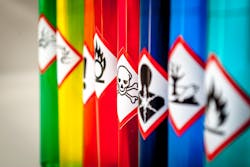NIOSH Adds Nine Chemicals to Skin Notation Profiles
Skin disease and exposure in the workplace exceeds the instance of respiratory illness at a rate of 3.4 injuries per 10,000 employees, according to the Bureau of Labor Statistics.
Because of the significant risk to chemicals in the workplace, The National Institute for Occupational Safety and Health (NIOSH) has published new skin notation profiles to “alert workers and employers to the health risks of skin exposures to chemicals in the workplace.”
The profiles are meant to “inform the audience – mostly occupational health practitioners, researchers, policy- and decision-makers, employers, and workers in potentially hazardous workplaces – so that improved risk-management practices may be developed to better protect workers from the risks of skin contact with the chemicals of interest,” NIOSH Director John Howard said.
Originally published in the NIOSH Pocket Guide to Chemical Hazards, the profiles provide supplemental information to the skin notation – in particular, specific hazards to skin from a certain chemical – including a summary of the relevant data used to help determine these hazards.
The new chemicals include:
- Arsenic and inorganic arsenic containing compounds
- Disulfoton
- Heptachlor
- 1-Bromopropane
- 2-Hydroxypropyl acrylate
- Dimethyl sulfate
- Tetraethyl lead
- Tetramethyl lead
- Trichloroethylene
NIOSH’s hazard identification ensures that the assigned skin notations reflect the contemporary state of scientific knowledge. It also provide transparency behind the assignment process, communicates the hazards of chemical exposures of the skin and attempts to meet the needs of health professionals, employers, and other interested parties in protecting workers from chemical contact with the skin.
A complete list of skin profiles can be found on NIOSH’s website.
